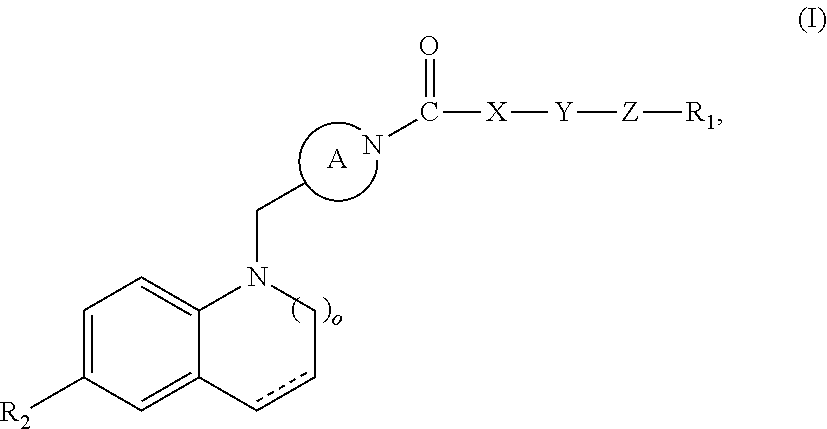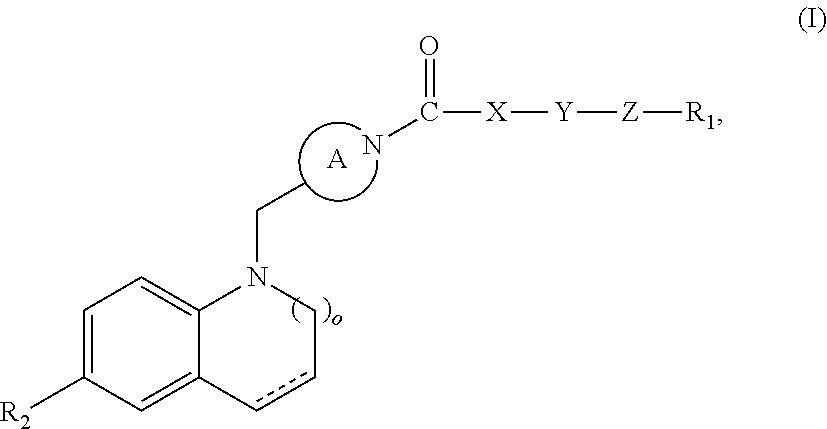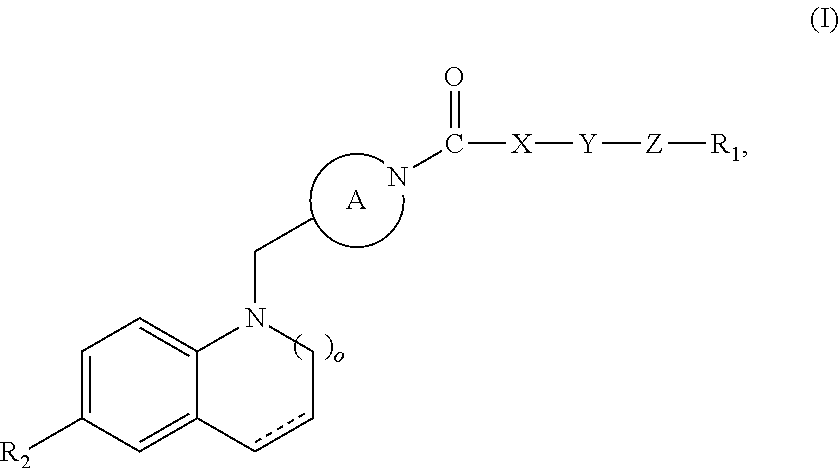Retinoic acid receptor-related orphan receptor modulators and uses thereof
a technology of orphan receptor and retinoic acid, which is applied in the field of retinoic acid receptor related orphan receptor (ror) regulated diseases and disorders, can solve problems such as relative imbalan
- Summary
- Abstract
- Description
- Claims
- Application Information
AI Technical Summary
Benefits of technology
Problems solved by technology
Method used
Image
Examples
example 1
Synthesis of 1-(7-azabicyclo[2.2.1]heptan-2-ylmethyl)-5-(1-(tetrahydro-2H-pyran-2-yl)-1H-pyrazol-4-yl)-1H-indole
[0168]
Reaction Step 1. Synthesis of ethyl 3-bromopropiolate
[0169]
[0170]Silver nitrite (1.72 g, 10.2 mmol, 0.1 eq) was added to a solution of ethyl propiolate (10.00 g, 102 mmol, 1.0 eq) in acetone (200 mL) at room temperature. The resulting reaction mixture was stirred for 5 min, then NBS (20.0 g, 112 mmol, 1.1 eq) was added and the reaction mixture stirred for 2 h at room temperature. After completion of the reaction (monitored by TLC, 5% ethyl acetate-hexane Rf=0.55), the reaction mixture was filtered through a celite pad, washing with acetone. The filtrate was concentrated under reduced temperature (25-30° C.) to afford an oil. The crude product was purified by flash column chromatography on silica gel (100-200 mesh), eluting with 10% diethyl ether in hexanes to afford ethyl 3-bromopropiolate (10.0 g, 58%) as a yellow oil. LCMS m / z=176.91 (M+1).
Reaction Step 2. Synthesi...
example 2
Synthesis of phenyl(2-((5-(1-(tetrahydro-2H-pyran-2-yl)-1H-pyrazol-4-yl)-1H-indol-1-yl)methyl)-7-azabicyclo[2.2.1]heptan-7-yl)methanone
[0189]
[0190]To a stirred solution of 1-(7-azabicyclo[2.2.1]heptan-2-ylmethyl)-5-(1-(tetrahydro-2H-pyran-2-yl)-1H-pyrazol-4-yl)-1H-indole (0.150 g, 0.398 mmol, 1.0 eq) in dichloromethane (5 mL) was added triethylamine (160 μL, 1.19 mmol, 3.0 eq), the mixture was cooled to 0° C., then benzoyl chloride (33 μL, 0.438 mmol, 1.1 eq) was slowly added. The mixture was stirred for 2 h at room temperature. After completion of the reaction (monitored by TLC, 70% ethyl acetate-hexane Rf=0.6), the reaction mixture was quenched with saturated sodium bicarbonate solution and extracted with dichloromethane. The organic layer was washed with brine, dried over anhydrous sodium sulfate and concentrated under reduced pressure. The crude mass was purified by flash column chromatography on silica gel (100-200 mesh), eluting with 50% ethyl acetate in hexanes to afford phen...
examples 3-7
[0191]Using the procedure described in Example 2, starting with 1-(7-azabicyclo[2.2.1]heptan-2-ylmethyl)-5-(1-(tetrahydro-2H-pyran-2-yl)-1H-pyrazol-4-yl)-1H-indole and the acid chlorides indicated, the compounds shown in table were prepared.
LCMSm / e:AcidYield(M + 1); Tr / Ex.ChlorideChemical Name(%)purity32-phenyl-1-(2-((5-(1-(tetrahydro-2H- pyran-2-yl)-1H-pyrazol-4-yl)-1H-indol- 1-yl)methyl)-7-azabicyclo[2.2.1]heptan- 7-yl)ethanone65%m / e: 495.6; TR = 2.231; 93%43-phenyl-1-(2-((5-(1-(tetrahydro-2H- pyran-2-yl)-1H-pyrazol-4-yl)-1H-indol- 1-yl)methyl)-7-azabicyclo[2.2.1]heptan- 7-yl)propan-1-one44%m / e: 509.6; TR = 2.33; 96%5cyclohexyl(-2-((5-(1-(tetrahydro-2H- pyran-2-yl)-1H-pyrazol-4-yl)-1H-indol- 1-yl)methyl)-7-azabicyclo[2.2.1]heptan- 7-yl)methanone58%m / e: 487.6; TR = 2.33; 99%62-cyclohexyl-1-(-2-((5-(1-(tetrahydro- 2H-pyran-2-yl)-1H-pyrazol-4-yl)-1H- indol-1-yl)methyl)-7- azabicyclo[2.2.1]heptan-7-yl)ethanone52%m / e: 501.2; TR = 2.37; 97%73-methyl-1-(2-((5-(1-(tetrahydro-2H- pyran-2-y...
PUM
 Login to View More
Login to View More Abstract
Description
Claims
Application Information
 Login to View More
Login to View More - R&D
- Intellectual Property
- Life Sciences
- Materials
- Tech Scout
- Unparalleled Data Quality
- Higher Quality Content
- 60% Fewer Hallucinations
Browse by: Latest US Patents, China's latest patents, Technical Efficacy Thesaurus, Application Domain, Technology Topic, Popular Technical Reports.
© 2025 PatSnap. All rights reserved.Legal|Privacy policy|Modern Slavery Act Transparency Statement|Sitemap|About US| Contact US: help@patsnap.com



